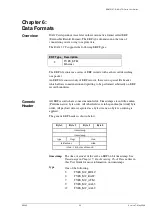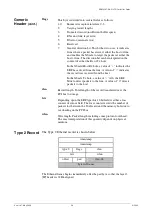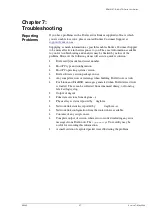
EDM01-07: DAG 3.7G Card User Guide
©2005
15
Version 7: May 2006
Process
Description
Packet
Transmission
(cont.)
Packet
transmission utility
The
dagflood
utility can transmit ERF format packet
traces. The ERF trace file to be transmitted must
contain only ERF records of the type matching the
current link configuration.
The ERF records to be transmitted must have a length
which is a multiple of 64-bits. When capturing a packet
trace for later transmission, the 64-bit alignment can be
set using the
dagthree align64
command. The 64-bit
alignment is permanently set on the DAG 3.7G card.
Convert trace files. It is also possible to convert trace files that have been
captured without the
align64
option. This can be done
with the command:
dagconvert -v -i in.erf -o out.erf -A8
If uncertain that a trace file is 64-bit aligned for
transmission with
dagflood
, the file can be tested with:
dagbits -vvc align64 -f tracefile.erf
If a captured trace file is not available, the
daggen
program is capable of generating trace files containing
simple traffic patterns. This allows the DAG card to be
used as a test traffic generator.
Capture received
traffic while
transmitting.
You can capture received traffic while transmitting.
Capture programs such as
dagsnap
,
dagconvert
, and
dagbits
can be used while
dagflood
is sending packets.
Configuring DAG
card for
transmission.
To configure a DAG card for transmission, some
memory must be allocated to a transmit stream.
In the
dagthree
output,
buf=nMB
indicates that
n
megabytes of memory has been allocated to this DAG
card in total. his memory can be split between the
available receive and transmit stream buffers. The
memory allocation is displayed with
mem=X:Y
, where
X is the amount of memory allocated to receive stream
0 in MB, and Y is the amount of memory allocated to
transmit stream 1 in MB.
By default the memory is evenly split between the
receive streams, the transmit streams have no memory
allocated. If the card is to be used only for transmit, the
dagthree
txonly
option can be used to recover the
receive buffer memory and assign all the memory to
transmit.
If the card is to be used for both transmitting and
receiving, the
rxtx
option can be used. This allocates
16MB of memory to each transmit stream, and divides
the remaining memory between the receive streams.
Alternatively the memory allocation can be directly set
with
mem=X:Y
option. The stream buffer memory
allocation can only be changed when no packet capture
or transmission programs are running.
Summary of Contents for DAG 3.7G Series
Page 1: ......
Page 4: ...EDM01 07 DAG 3 7G Card User Guide Version 7 May 2006 2005...
Page 18: ...EDM01 07 DAG 3 7G Card User Guide Version 7 May 2006 12 2005...
Page 30: ...EDM01 07 DAG 3 7G Card User Guide Version 7 May 2006 24 2005...
Page 34: ...EDM01 07 DAG 3 7G Card User Guide Version 7 May 2006 28 2005...














































